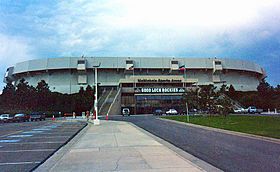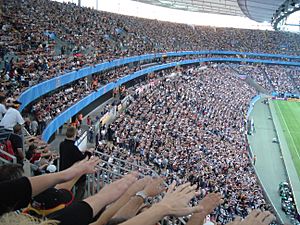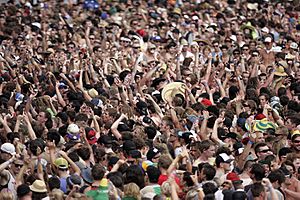Wave (audience) facts for kids
| Wave/Mexican wave | |
|---|---|
 First performed at McNichols Sports Arena (1979) |
|
| Origin | |
| Date: | 15 November 1979 |
| Created by: | Krazy George Henderson |
| League: | National Hockey League (NHL) |
| Venue: | McNichols Sports Arena |
| Game: | Rockies vs. Canadiens (1 : 4) |
| Place: | Denver, Colorado |
| Sport: | Ice hockey |
| Earliest footage | |
| Broadcast: | 15 October 1981 |
| League: | Major League Baseball (MLB) |
| Venue: | Oakland Coliseum |
| Place: | Oakland, California |
| Game: | Athletics vs. Yankees (0 : 4) |
| Sport: | Baseball |

The wave is a cool movement that happens in a crowded stadium. People stand up, yell, and raise their arms one after another. Then, they quickly sit back down.
This creates a "wave" of standing people that moves through the crowd. It looks like a real wave, but no one actually leaves their seat! In many big stadiums, the seats go all the way around the field. This lets the wave travel continuously in a circle. Sometimes, if there's a small gap in the seats, the wave can even jump across it. Usually, only one wave goes around at a time. But sometimes, two waves can go in opposite directions!
The wave first appeared in sports events in the United States in the late 1970s and early 1980s. It became famous around the world after the 1986 FIFA World Cup in Mexico was shown on TV. That's why it's often called a "Mexican wave" in many countries outside of North America.
Contents
How the Wave Started
Krazy George Henderson's Story
Many people believe the wave started on November 15, 1979. It happened at a National Hockey League (NHL) game. The game was between the Colorado Rockies and the Montreal Canadiens. It took place at McNichols Sports Arena in Denver, Colorado.
A cheer leader named Krazy George Henderson helped make the wave popular. He led the first wave that was ever recorded on video. This happened on October 15, 1981, at a Major League Baseball game in Oakland, California. This wave was shown on TV. George used this video to show that he helped invent the wave.
George thinks the wave started by accident. He was leading cheers at a Colorado Rockies hockey game in 1979. His usual cheer was for one side of the arena to jump and cheer, then the other side would respond. One night, a section of fans jumped up a few seconds later than the section next to them. The next section of fans followed, and soon, the first wave went all the way around the arena by itself!
The University of Washington's Part
Some people from the University of Washington also helped make the wave popular. A former cheerleader named Robb Weller said that in the early 1970s, they had a different kind of wave. Their wave went from the bottom of the stands to the top, not side to side.
The first wave at the University of Washington's Husky Stadium happened on Halloween in 1981. It was started by a band trumpet player, Dave Hunter, and the visiting alumni cheerleader, Weller. In 1982, the football coach, Don James, even said the crowd noise from the wave helped them win home games!
The University of Michigan's Part
In 1983, the Michigan Wolverines played the Huskies in Seattle. They saw the wave and brought it back to Michigan Stadium in Ann Arbor. Fans loved it because it was fun, especially when their team was winning by a lot.
The coach, Bo Schembechler, even asked fans not to do the wave. But the fans did it even more! They made "Silent Waves" (standing without cheering) and "Shsh Waves" (making a "shshing" sound). They also did "Fast Waves," "Slow Waves," and even two waves at the same time going in opposite directions. The next spring, fans brought the wave to Tiger Stadium in Detroit. The Tigers won the 1984 World Series that year. Many people across the US saw the wave on TV during their games.
The Wave Goes Global
1984 Olympic Football Final
The wave was seen by people all over the world during the 1984 Olympic football final. This game was between Brazil and France on August 11. About 100,000 people did the wave at the Rose Bowl in Pasadena, California.
1986 FIFA World Cup in Mexico
Most sports experts agree that the wave became truly famous worldwide during the 1986 FIFA World Cup in Mexico. This event was broadcast to a huge global audience. It was the first time many people outside North America had ever seen the wave. Because of this, English speakers outside of North America started calling it a "Mexican wave."
In many languages, like Polish and Turkish, they use a direct translation of "Mexican Wave." In Germany, Italy, and other countries, it's called "la ola." This comes from the Spanish word for "wave." In countries where people speak Portuguese, like Brazil, it's called a onda or [o] ondão, but a ola is also used.
The Wave Today

Today, you can often see the wave at sports events. It's especially common when there's a quiet moment in the game and fans want to have fun. Some fans think the wave shouldn't be done during important parts of a game.
At the Melbourne Cricket Ground in Australia, people in the special Members' Stand used to refuse to do the wave. Other fans would boo them, and then the wave would continue on the other side of the stand. This was a fun way to show that everyone was equal at the game. Even when the Members' Stand was empty for repairs, people still booed it!
Cricket Australia tried to ban the wave at home games in 2007. They said that liquids and other things thrown during the wave could be dangerous. But this ban didn't work well. In fact, it sometimes made more people do the wave! Even an Australian cricket player, Adam Gilchrist, joined in a banned wave from the field. The ban is sometimes put in place and then lifted again.
How the Wave Works
In 2002, scientists studied videos of 14 waves at big Mexican football stadiums. They found out some interesting things about how waves work. It only takes a few dozen fans to start a wave. Once it starts, it usually moves in a clockwise direction. It travels about 12 meters (about 39 feet) per second. This means it moves past about 22 seats every second. At any moment, the wave is about 15 seats wide. These facts seem to be true for waves in different sports and countries.
Wave Records
On June 23, 2019, a new record was set for the longest continuous wave. It happened during the Rocket League Championship Series (a video game e-sports event) Season 7 Finals. The audience at the Prudential Center in Newark, New Jersey, kept the wave going for 28 minutes and 35 seconds! The old record was 17 minutes and 14 seconds. That was set by the band Tube and their fans at a concert in Japan in 2015.
See also
 In Spanish: La ola para niños
In Spanish: La ola para niños
- Card stunt

